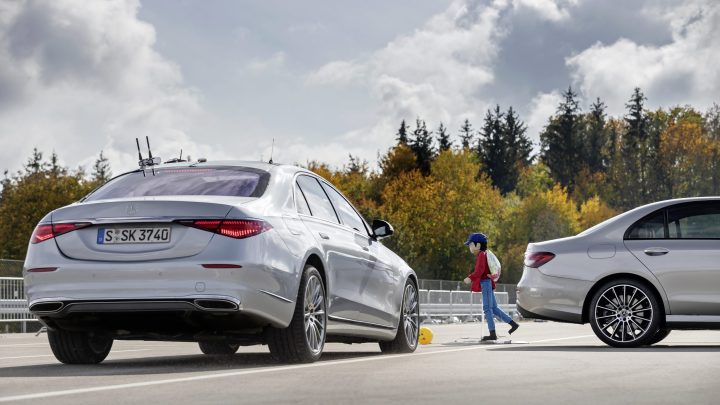
Mercedes-Benz, with its arsenal of over 40 active assistance systems, stands at the forefront of enhancing road safety for all users. Among these, the Active Brake Assist with pedestrian detection has proven instrumental in mitigating accidents involving pedestrians and cyclists across various driving scenarios.
This system is equipped to deliver both visual and acoustic warnings in anticipation of a potential collision with intersecting or oncoming vehicles. If the driver’s braking response is deemed insufficient, the system intervenes, augmenting braking force according to the necessity. In cases where the driver remains unresponsive, the Active Brake Assist initiates emergency braking. Employing camera and radar-based sensors, the system adeptly identifies pedestrians and cyclists in the vehicle’s path, calculating the requisite braking force to either prevent or minimize a collision.

Mercedes-Benz has reached a significant safety milestone, having integrated the pedestrian emergency braking system into over 10 million of its passenger cars sold worldwide since 2012. This feature holds particular significance for protecting vulnerable road users who lack the protective measures afforded by airbags, seat belts, or protective clothing. Disturbingly, statistics underline the elevated risk pedestrians face, constituting nearly one-fifth of all road fatalities in the European Union in 2020 and 17 percent in the United States in 2021.
Studies affirm the efficacy of such systems, with the American Insurance Institute for Highway Safety reporting a 27 percent reduction in pedestrian-involved accidents for vehicles equipped with pedestrian emergency braking compared to those without.
Mercedes-Benz has a rich history of advancing safety systems, introducing the Brake Assist System in 1996 and progressively enhancing it with radar technology in 2005. The integration of anticipatory features and the combination of DISTRONIC PLUS distance control and BAS PLUS Brake Assist led to the creation of PRE-SAFE® Brake with autonomous partial braking in 2006. The crucial pedestrian detection feature was added in 2013 and became standard in the E-Class in 2016.

Setting a benchmark for internal safety standards, since 2021, Active Brake Assist is a standard feature across all new Mercedes-Benz car models. This precedes the mandatory requirement, effective from July 2022, for city emergency brake assist systems for low-speed driving in all newly approved passenger cars in the EU. Further regulations mandate these systems for all newly registered cars from 2024.
The future holds promise for even more potent assistance systems, capitalizing on advanced sensors and artificial intelligence. The commitment to the “Real-Life Safety” philosophy underscores Mercedes-Benz’s dedication to systematic accident research spanning over 50 years. The ultimate objective is “Vision Zero” – eradicating accidents involving Mercedes-Benz vehicles entirely by 2050, exemplifying a commitment to the holistic safety of all road users.


